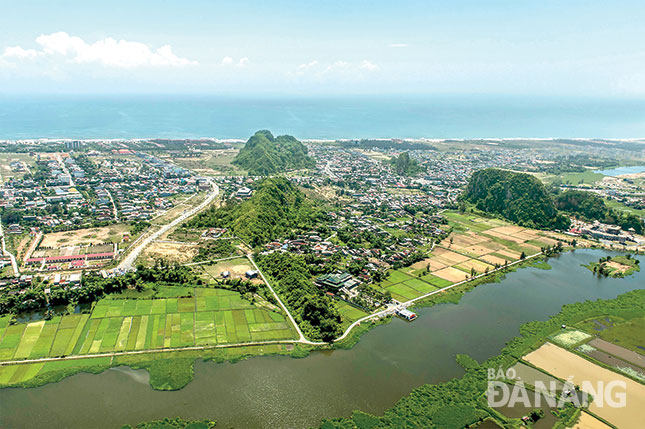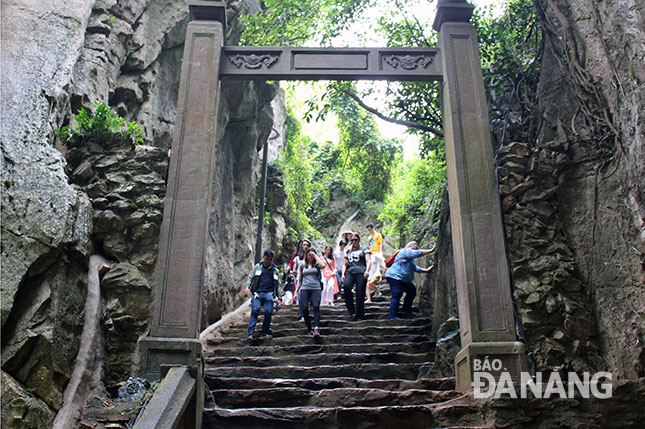Marble Mountains - precious gift of nature to the city
The Marble Mountains Tourist Area in Hoa Hai Ward, Ngu Hanh Son District, Da Nang, shows off its special historical and cultural values. It, therefore, is completely eligible to be recognised as a special national-level relic site in the coming time.
 |
| The Marble Mountains viewed from above (Photo: Dang No) |
The site was officially recognised as a national-level relic site by the Ministry of Culture, Sports and Tourism in 1990.
The Marble Mountains site is a cluster of 5 marble and limestone mountains lying close to the sea, located about 10 km south of the city centre.
Each mountain is named after one of the 5 elements in ancient oriental philosophy: metal, wood, water, fire and earth.
As a precious gift of nature endowed to the city, the Marble Mountains site is one of the most popular beauty spots in the central region, and a must-see place for every visitor to Da Nang.
The site is home to splendid scenery, pagodas, and grottoes, seducing travellers by the tranquil air and beautiful natural settings.
A lot of the legends and folklore about the mountains have been spread through by word of mouth.
Anyone visiting there is likely to come across someone - a child or a grey-haired old local selling incense or souvenirs-who will gladly tell some of the stories about the mountains of which they are so proud.
One local tale is that the mountains originate from egg shells. Legend has it that a golden turtle came to the seashore and laid 5 eggs a long time ago. When the eggs hatched, their shells turned into the 5 mountains.
Each mountain is made of different colored marble-there is pink marble in Water Mountain, white marble in Wood Mountain, red marble in Fire Mountain, water-coloured marble in Metal Mountain and brown marble in Earth Mountain.
The colours change under different lighting conditions, and poets have compared the view to a beautiful girl contemplating the wind-swept East Sea.
 |
| The mysterious allure of the Marble Mountains Tourist Area helps to attract thousands of visitors every day (Photo: Ngoc Ha) |
King Minh Mang made his imperial journeys to the Marble Mountains for 3 occasions in total during his reign.
It was also King Ming Mang who named the venue “Ngu Hanh Son” in Vietnamese after the 5 elements, and added it to the cadastral map of Dai Nam, which was the name of Viet Nam over the 1838 - 1945 period.
The King ordered the refurbishment of the Tam Thai Pagoda, and the construction of the Ung Chan Pagodo at the venue.
The site inspired many great poets ensuring them a place on the map of Vietnamese literature.
Poems from the Le and Tran dynasties have been preserved for young generations to enjoy in handwriting carved into the walls of caves high up in the cliffs. Pagodas built to honour the rulers of the Dinh, Ly, Tran and Le dynasties contain many valuable old objects and artifacts.
Many archaeological research works show that the Marble Mountains site is a residential area for the Champa people from the 7th to 9th centuries.
With a dense concentration of pagodas and Buddha statues and other Buddhist cultural artifacts, the venue is also one of the Buddhist hubs in Central Viet Nam.
In terms of feng-shui, the site is the sacred land showing off the beauty of convergence: mountains, plains, rivers and sea.
Interestingly, “Ngu Hanh Son” and the mountains of Phuoc Tuong, Ba Na, Hai Van and Son Tra together look like ‘fingers’ put up to protect the ‘palm’ which is the embodiment of the land of the city.
Mr Bui Van Tieng, the Chairman of the city’s Historical Science Association, said the Marble Mountains site is one of the most important venues during the gradual southward expansion of the Vietnamese territory from its original heartland in the Red River Delta in the past.
The building of the Vong Hai Pavillion offering a panorama view of the sea during the Nguyen feudal dynasty demonstrates the special concern over national defence at that time.
Furthermore, the site was an important revolutionary base during the 2 resistance wars against the French and the Americans.
The city authorities will ask the Ministry of Culture, Sports and Tourism to complete all necessary documents in order for them to be submitted to the Prime Minister for approval for the recognition of the Marble Mountains as a special national-level relic site as soon as possible.